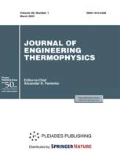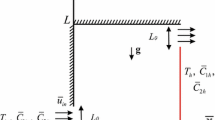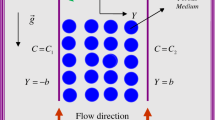Abstract
A triple diffusive convective flow (thermal diffusion and dual species diffusion) in a viscous fluid flowing within a vertical duct is investigated under the Robin boundary conditions at the duct walls. Viscous heating and homogenous chemical reaction effects are included. The mass transfer (solutal) buoyancy effects due to concentration gradients of the dispersed components are taken into account using the Boussinesq approximation. Symmetric and asymmetric wall conditions for the temperature are taken into account. The conservation equations are rendered into a dimensionless form via suitable transformations, and the emerging ordinary differential equations feature a number of dimensionless parameters. Those include the thermal Grashof number, two solutal Grashof numbers (one for each of the diffusing components, i.e., species 1 and species 2), left and right duct wall thermal Biot numbers, species 1 and species 2 chemical reaction parameters, Brinkman number, and temperature difference ratio. These coupled and nonlinear dimensionless conservation equations are solved numerically using the Runge-Kutta shooting method. The solutions obtained numerically are validated with approximate analytical solutions obtained via a regular perturbation method, which are valid for small values of the Brinkman number. The effect of selected parameters on the velocity, temperature, and dual species concentration distributions is presented graphically. Furthermore, the variation of the skin friction and the Nusselt number with these parameters is tabulated. The solutions obtained numerically and analytically are found to be equal in the absence of viscous dissipation. However, the deviation grows with large values of the Brinkman number. In the absence of chemical reaction, the results concur with the earlier computations by Zanchini (1998). Increase in the second species solutal Grashof number is observed to decelerate the flow in the left duct half space, accelerate the flow in the right duct half space, and consistently reduce the temperatures across the entire duct width. With rise in the species 1 chemical reaction parameter, the concentration magnitudes increase in the left duct half space and decrease in the right duct half space. A similar response is computed for the influence of the species 2 reaction parameter on the concentration profile. The temperatures are strongly enhanced across the duct width with increase in the Brinkman number and are symmetric about the channel centerline for the symmetric Biot number case (equal thermal Biot numbers at the left and right walls). These profiles change in the asymmetric Biot number case (equal thermal Biot numbers at the left and right walls). The temperatures descend from the left wall toward the right wall, although they are still enhanced with increase in the Brinkman number. The simulations are relevant to geochemical transport phenomena, industrial materials processing, and thermal duct design.
Similar content being viewed by others
REFERENCES
Langlois, W.E., Buoyancy-Driven Flows in Crystal-Growth Melts,Ann. Rev. Fluid Mech., 1985, vol. 17, pp. 191–215.
Anjalidevi, S.P. and Kandasamy, R., Effects of Chemical Reaction, Heat and Mass Transfer on Laminar Flow along a Semi Infinite Horizontal Plate, Heat Mass Transfer, 1999, vol. 35, pp. 465–467.
Muthucumaraswamy, R., Chandrakala, P., and Raj, S.A., Radiative Heat and Mass Transfer Effects on Moving Isothermal Vertical Plate in the Presence of Chemical Reaction, Int. J. Appl. Mech. Eng., 2006, vol. 11, pp. 639–646.
Mehmood, R., Rana, S., Anwar Bég, O., and Kadir, A., Numerical Study of Chemical Reaction Effects in Magnetohydrodynamic Oldroyd-B Oblique Stagnation Flow with a Non-Fourier Heat Flux Model,J. Brazilian Soc. Mech. Sci. Engin., 2018; https://doi.org/10.1007/s40430-018-1446-4.
Takhar, H.S., Chamkha, A.J., and Nath, G., Flow and Mass Transfer on a Stretching Sheet with a Magnetic Field and Chemically Reactive Species, Int. J. Eng. Sci., 2000, vol. 38, pp. 1303–1314.
Shamshuddin, M., Mishra, S.R., Kadir, A., and Anwar Bég, O., Unsteady Chemo-Tribological Squeezing Flow of Magnetized Bioconvection Lubricants: Numerical Study, J. Nanofluids, 2019, vol. 8, no. 2, pp. 407–419.
Ibrahim, F.S., Elaiw, A.M., and Bakr, A.A., Effect of the Chemical Reaction and Radiation Absorption on the Unsteady MHD Free Convection Flow past a Semi-Infinite Vertical Permeable Moving Plate with Heat Source and Suction, Comm. Nonlin. Sci. Num. Simul., 2008, vol. 13, pp. 1056–1066.
Shamshuddin, M., Mishra, S.R., Anwar Bég, O., and Kadir, A., Lie Symmetry Analysis and Numerical Solutions for Thermo-Solutal Chemically Reacting Radiative Micropolar Flow from an Inclined Porous Surface, Heat Transfer-Asian Res., 2018, vol. 47, no. 7, pp. 918–940; DOI: 10.1002/htj.21358.
Gebhart, B., Jaluria, Y., Mahajan, R.L., and Sammakia, B.,Buoyancy-Induced Flows and Transport, New York: Hemisphere, 1988.
Umavathi, J.C., and Sultana, J., Mixed Convection Flow of a Micropolar Fluid with Concentration in a Vertical Channel in the Presence of Heat Source or Sink, Int. J. Math. Arch., 2012, vol. 3, pp. 3556–3569.
Liu, I.-C. and Umavathi, J.C., Double Diffusive Convection of a Micropolar Fluid Saturated in a Sparsely Packed Porous Medium,Heat Transfer-Asian Res., 2013, vol. 42, pp. 515–529.
Umavathi, J.C. and Mohite, M.B., Double Diffusive Convective Transport in a Nanofluid-Saturated Porous Layer with Cross Diffusion and Variation of Viscosity and Conductivity, Heat Transfer-Asian Res., 2014, vol. 43, pp. 628–652.
Umavathi, J.C. and Sheremet, M.A., Onset of Double-Diffusive Convection of a Sparsely Packed Micropolar Fluid in a Porous Medium Layer Saturated with a Nanofluid, Microfluidic Nanofluid, 2017, vol. 21, pp. 121–128.
Celia, M.A., Kindred, J.S., and Herrera, I., Contaminant Transport and Biodegradation. A Numerical Model for Reactive Transport in Porous Media, Water Resources Res., 1989, vol. 25, pp. 1141–1148.
Chen, B., Cunningham, A., Ewing, R., Peralta, R., and Visser, E., Two-Dimensional Modeling of Micro Scale Transport and Biotransformation in Porous Media, Num. Meth. Part. Diff. Eqs., 1994, vol. 10, pp. 65–83.
Griffiths, R.W., The Influence of a Third Diffusing Component upon the Onset of Convection, J. Fluid Mech., 1979, vol. 92, pp. 659–670.
Griffiths, R.W., A Note on the Formation of Salt-Finger and Diffusive Interfaces in Three-Component Systems, Int. J. Heat Mass Transfer, 1979, vol. 22, pp. 1687–1693.
Griffiths, R.W., The Transport of Multiple Components Through Thermohaline Diffusive Interfaces, Deep-Sea Res., 1979, vol. 26, pp. 383–397.
Rudraiah, N. and Vortmeyer, V.D., Influence of Permeability and of a Third Diffusing Component upon the Onset of Convection in a Porous Medium, Int. J. Heat Mass Transfer, 1982, vol. 25, pp. 457–464.
Poulikakos, D., Effect of a Third Diffusing Component on the Onset of Convection in a Horizontal Layer, Phys. Fluids, 1985, vol. 28, pp. 3172–3174.
Pearlstein, A.J., Harris, R.M., and Terrones, G., The Onset of Convective Instability in a Triply Diffusive Fluid Layer,J. Fluid Mech., 1989, vol. 202, pp. 443–465.
Khan, Z.H., Khan, W.A., and Pop, I., Triple Diffusive Free Convection along a Horizontal Plate in Porous Media Saturated by a Nanofluid with Convective Boundary Condition, Int. J. Heat Mass Transfer, 2013, vol. 66, pp. 603–612.
Shivakumara, I.S. and Naveen Kumar, S.B., Linear and Weakly Nonlinear Triple Diffusive Convection in a Couple Stress Fluid Layer, Int. J. Heat Mass Transfer, 2014, vol. 68, pp. 542–553.
Prakash, J., Bala, R., Vaid, K., and Kumar, V., On Arresting the Complex Growth Rates in Rotatory Triply Diffusive Convection,Applic. Appl. Math.: Int. J., 2016, vol. 11, pp. 722–734.
Ghalambaz, M., Moattar, F., Karbassi, A., Sheremet, M.A., and Pop, I., Triple-Diffusive Mixed Convection in a Porous Open Cavity,Transport Por. Media, 2016, vol. 116, pp. 473–491.
Wibulswas, P., Laminar Flow and Heat Transfer in Non-Circular Ducts, Ph.D. Thesis, London University, 1966.
Hicken, E., Das temperaturfeld in laminar durchstromten Kanalen Mitechteckquerschnit bei unterschiedlicher Beheizung der Kanalwade, Warme Stoffubertragung, 1968, vol. 1, pp. 98–104.
Javeri, V., Laminar Heat Transfer in a Rectangular Channel for the Temperature Boundary Condition of the Third Kind,Int. J. Heat Mass Transfer, 1978, vol. 10, pp. 1029–1034.
Zanchini, E., Effect of Viscous Dissipation on Mixed Convection in a Vertical Channel with Boundary Conditions of the Third Kind, Int. J. Heat Mass Transfer, 1998, vol. 41, pp. 3949–3959.
Umavathi, J.C., Prathap Kumar, J., and Sultana, J., Mixed Convection Flow in a Vertical Channel with Boundary Conditions of the Third Kind in the Presence of Heat Source/Sink, Appl. Math. Mech., 2012, vol. 33, pp. 1015–1034.
Umavathi, J.C., and Veershetty, S., Non-Darcy Nixed Convection in a Vertical Porous Channel with Boundary Conditions of Third Kind, Transport Por. Media, 2012, vol. 95, pp. 111–131.
Umavathi, J.C., Kumar, J.P., and Sultana, J., Mixed Convection Flow in a Vertical Porous Channel with Boundary Conditions of Third Kind with Heat Source/Sink, J. Por. Media, 2012, vol. 15, pp. 998–1007.
Umavathi, J.C. and Sultana, J., Mixed Convective Flow of Micropolar Fluid Mixture in a Vertical Channel with Boundary Conditions of Third Kind, J. Engin. Phys. Thermophys., 2012, vol. 85, pp. 895–908.
Prathap Kumar, J., Umavathi, J.C., Chamkha, A.J., and Ramarao, Y., Mixed Convection of Electrically Conducting Viscous Fluid in a Vertical Channel Using Robin Boundary Conditions,Canadian J. Phys., 2015, vol. 93, pp. 698–710.
Prathap Kumar, J., Umavathi, J.C., Chamkha, A. J., and Ramarao, Y., Mixed Convective Heat Transfer of Immiscible Fluids in a Vertical Channel with Boundary Conditions of the Third Kind,Comput. Therm. Sci., 2017, vol. 9, pp. 447–465.
Anwar Bég, O., Uddin, M.J., Rashidi, M.M., and Kavyani, N., Double-Diffusive Radiative Magnetic Mixed Convective Slip Flow with Biot and Richardson Number Effects, J. Eng. Therm., 2014, vol. 23, no. 2, pp. 79–97.
Uddin, M.J., Anwar Bég, O., Aziz, A., and Ismail, A.I.M., Group Analysis of Free Convection Flow of a Magnetic Nanofluid with Chemical Reaction, Math. Problems Engin., 2015; Article ID 621503; DOI:10.1155/2015/621503.
Latiff, N.A., Uddin, M.J., Anwar Bég, O., and Ismail, A.I.M., Unsteady Forced Bioconvection Slip Flow of a Micropolar Nanofluid from a Stretching/Shrinking Sheet, Proc. IMECHE–Part N: J. Nanomat., Nanoengin. Nanosyst., 2016, vol. 230, no. 4, pp. 177–187.
Uddin, M.J., Anwar Bég, O., and Ismail, A.I., Radiative-Convective Nanofluid Flow past a Stretching/Shrinking Sheet with Slip Effects, AIAA J. Thermophys. Heat Transfer, 2015, vol. 29, no. 3, pp. 513–523.
Prakash, J., Siva, E.P., Tripathi, D., Kuharat, S., and Anwar Bég, O., Peristaltic Pumping of Magnetic Nanofluids with Thermal Radiation and Temperature-Dependent Viscosity Effects: Modelling a Solar Magneto-Biomimetic Nanopump, Renewable Energy, 2018; doi.org/10.1016/j.renene.2018.08.096 0960-1481.
Vasu, B., Atul Kumar Ray, Anwar Bég, O., and Rama Subba Reddy Gorla, Magneto-Bioconvection Flow of a Casson Thin Film with Nanoparticles over an Unsteady Stretching Sheet: HAM and GDQ Computation, Int. J. Num. Meth. Heat Fluid Flow, 2019; doi.org/10.1108/HFF-02-2019-0158.
Manzoor, N., Anwar Bég, O., Maqbool, K., and Shaheen, S., Mathematical Modelling of Ciliary Propulsion of an Electrically-Conducting Johnson–Segalman Physiological Fluid in a Channel with Slip, Computer Methods Biomech. Biomed. Engin., 2019; https://doi.org/10.1080/10255842.2019.1582033.
Author information
Authors and Affiliations
Corresponding authors
Rights and permissions
About this article
Cite this article
Umavathi, J.C., Anwar Bég, O. Mathematical Modelling of Triple Diffusion in Natural Convection Flow in a Vertical Duct with Robin Boundary Conditions, Viscous Heating, and Chemical Reaction Effects. J. Engin. Thermophys. 29, 348–373 (2020). https://doi.org/10.1134/S1810232820020162
Received:
Revised:
Accepted:
Published:
Issue Date:
DOI: https://doi.org/10.1134/S1810232820020162




